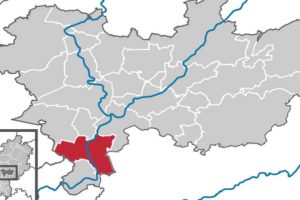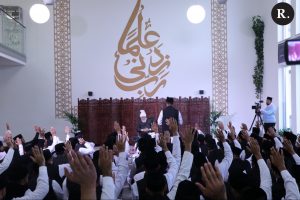Sabahat Ali, Canada reporting from London
Part and Parcel of Prophethood

The Ahmadiyya Muslim Community witnesses divine promises fulfilled even today. One of the most compelling proofs of this is the phenomenon of migration in the face of overwhelming persecution from those who not only seek to kill prophets, but to eliminate their entire community and everything that they stand for.
History bears witness to this. From the unrelenting cruelties of Egyptian Pharaonic dynasties upon the people of Mosesas and the brutal barbarities meted out to Jesusas of Nazareth by Caesar, to the malicious mauling and mutilation by the Holy Prophet Muhammad’ssa own kith and kin against him and his followers, the sands of time tell a tale of turmoil endured with astonishing grace by the followers of prophets in every era.
That is, until the heavens cast open for them a way out. This is the phenomenon of migration, an affair which sometimes appears to the onlookers as defeat, but in reality is a grand victory. It is the genius of God’s elect that in their humility, despite being the chosen ones of God, they choose to avoid conflict to the extent that they leave everything they hold dear – their homes, their towns, their people, their heritage, and migrate in the way of Allah.
God Almighty states,
‘And whoso emigrates from his country in the way of Allah will find in the earth an abundant place of refuge and plentifulness.’[1]
The Blessings of Migration Unravel with Time

And so, the Holy Qur’an has forever enshrined this golden secret for future generations to know that migrations are in fact victories, where the pain and agony of the emigrant is like the one endured by a farmer who tills the heaviest of soils. Yet, the harvests of coming seasons are unprecedented.
Hazrat Mirza Bashiruddin Mahmood Ahmadra, the second Khalifah (Caliph) of the Ahmadiyya Muslim Community, while addressing thousands one Eid morning, made this very point. He explained,
‘Ever since the prophets of God began to appear in the world, it has been the way of God that the trees planted by divine hands always progress and advance in the midst of torrential floods and storms…Hence, those torrential storms and floods which apparently seem to fall upon the work of God are in reality only falling upon the people, not the work and intention of God. This is only a trick of the eyes. Just like you must have observed while travelling on a train that even though it is the train that’s moving, it appears as though the trees passing by are moving. Similarly, when cyclones and deluges of trials fall upon divine communities, the followers think that these storms are descending upon the divine institutions, whereas the truth is that they are not falling upon the divine scheme of things, but upon individuals – those individuals who have believed in this divine scheme…’[2]
While the desperate conditions which compel divine communities to migrate sometimes look like defeat, it is in fact a vital turning point in the era of the prophet and his followers.
A Prophecy of Migration to the Promised Messiahas
And so it was to happen with the community of Hazrat Mirza Ghulam Ahmad, the Promised Messiahas and founder of the Ahmadiyya Muslim Community. While the persecution that he faced from Muslim, Hindu, and Christian factions during his lifetime was unrelenting – from death-threats to attempts on his and his followers’ lives – it was at least not supported by the government. Yet he announced that God has informed him that this persecution would reach such an extent that migration would become a mandate. To this effect, he wrote in 1885:
‘I once saw in a dream that an individual was writing my name. He wrote it half in Arabic and half in English. The phenomenon of migration is attached to prophets. However, whereas certain visions find fulfilment in the time of the prophet, others are fulfilled through his progeny or a follower of his. For example, the royal keys to the thrones of Caesar and Khosrow were given to the Holy Prophetsa. Yet, the physical territories of the two were conquered in the time of Umarra.’[3]
The Promised Messiahas also received other revelations elaborating the details of this prophecy, recorded in his magnum opus, Barahin-e-Ahmadiyya and also in his Arabic work, ‘Dafi’ul Balaa’. He writes, ‘The Christian people shall plot to inflict damage [upon you]. In response, God too shall plan and those days will be days of tests and trials*; and say, ‘O My Lord! Do Thou Grant me safe haven in a pure land. This [shall be] a spiritual variety of migration.’[4]
After his demise in May of 1908, Hazrat Mirza Ghulam Ahmadas was succeeded by his sincerest follower and adherent, Hazrat Maulvi Nooruddinra, the first Khalifah of the Ahmadiyya Community. After his demise in 1914, Hazrat Mirza Bashiruddin Mahmood Ahmadra, the son of the Promised Messiahas, became the second Khalifah, during whose blessed time the first migration of the community was to occur.
The Reality of ‘Hijrat’ & a Sinister Plot
Explaining what constitutes a migration, he explained, ‘After studying the revelations vouchsafed to the Promised Messiahas, it dawned upon me that there is a hijrat (migration) destined for us, and (that) the word hijrat is in fact intrinsically connected with the leader. Otherwise, people move from one place to another all the time, but no one calls that a hijrat. A hijrat is intrinsically connected with the leader.’[5]

By the 1940s, the situation in India had deteriorated so much that even the Indian government assumed a passive stance against terrorist groups trying to ‘purify’ the Indian population of Muslims, killing and massacring them in huge numbers. Having rejected the pristine and true Islam of the Holy Prophet Muhammadsa, which was revived by the Promised Messiahas, the general Muslim populace not only increased in its aggression, but in many cases joined forces against the Ahmadis.
As though the state-facilitated eradication of Ahmadis in India by Hindu and Sikh militias was not enough, the situation was about to get even worse. Describing this, Hazrat Musleh Ma’udra explains, ‘One can glean the antagonistic intentions of these people from [the following]. An English Colonel appointed in Batala came and told me, “I know what these people are planning. You cannot imagine the havoc that these people are about to wreak against the Muslims after August 31st.” While saying all this, the man was overwhelmed with tears, but forcefully composed himself, turning his face away.’[6]
So horrific were the plans to eradicate Muslims and Ahmadis in particular that even the hearts of those unbiased ones who had nothing to fear or lose bled in agony after them.
A Race Against the Clock and the Number Eleven

Describing the situation as he attempted to arrange transportation out of Qadian, Hazrat Khalifatul Masih IIra explains, ‘I was given to understand that it was God Almighty’s design and will that I leave Qadian. When I understood from the revelations of the Promised Messiahas that our migration is certain, and it was decided that I should now leave Qadian, a phone call was made to Lahore to arrange some means of transport. However, for 8-10 days, we received no response at all. When it did finally come, it was only that the government had outright refused to provide any means of conveyance, so no car could be given to us. At that time, I was studying the revelations of the Promised Messiahas. While reading them, I came across a particular revelation, “Ba’d Gyaarah” meaning “after eleven,” or “after the eleventh.” I took this to mean the 11th day on the calendar, and that in relation to the transportation, it meant that something would be arranged after the 11th of the lunar calendar. We waited and waited until the 28th of the Gregorian calendar arrived, and no arrangements had been made for transport from Qadian.’
As the situation escalated unfavourably for Ahmadis, the humble community’s faith in any state support waned to a flicker. Soon it became life-threatening for all Ahmadis in general and their beloved Khalifah in particular. Hazrat Musleh Ma’udra explains,
‘On the 28th, the government issued an announcement that after 31st August, the local government of each area would be responsible for its own security. This meant that the Indian Union had taken full control of Qadian. I resolved then and there that if I was to leave, I must try to do something immediately, otherwise leaving Qadian would become impossible.’[7]
A Final Attempt to Leave Qadian
After some research and having exhausted all their resources, it was decided that at least three Jeeps were required to form the caravan which would transport the Khalifah. Additionally, several back-up plans were put into place in case any person failed. As the night of departure drew near, however, each and every person who had promised to provide vehicles began to send messages that they would not be able to follow through with their promise – so perilous was the situation in Qadian.
‘All the while,’ Hazrat Musleh Ma’udra explains, ‘my mind was fixed on what the revelation “After the Eleventh” meant.’
Finally, the very last person who was due to arrive by eight or nine in the evening also failed to show up. Hazrat Musleh Ma’udra waited as the hour passed and the clock struck 10 p.m.
‘At that point,’ he explained, ‘it occurred to me that perhaps the words “after eleven” meant after eleven o’clock, and that some arrangement would materialise after 11 p.m. I continuously received messages from Mian Bashir Ahmad, M.A, under whose management the transport was, that each and every one of the measures and arrangements that had been made had either cancelled or failed to show up. I called him and told him that “I have understood the revelation after eleven to mean that something will be arranged after 11 p.m.”’[8]
‘After this, my other boy, Nasir Ahmad, who was overseeing the external arrangements also called. “All our efforts, all our arrangements, have failed,”’ he revealed.
He continued, ‘A Buddhist military officer had vowed that “even if I am punished, I will definitely find some sort of arrangement, and will even bring my own guards if I have to,” but at the last second, he was also reassigned elsewhere.’
Finally, the clock struck eleven. Both Hafiz Mirza Nasir Ahmad, supervisor of external transportation, and Mirza Bashir Ahmad, who was overall in charge of transporting Khalifatul Masih safely outside of Qadian, had made it clear that all their attempts to secure a way out of Qadian had been unsuccessful.
The clock struck 11:05 p.m., and Hazrat Khalifatul Masih IIra picked up the phone, intending to call Mian Nasir Ahmad again.
Mirza Nasir Ahmad picked up and exclaimed, ‘I was just about to call you. Captain Attaullah has arrived along with all of the vehicles!’
‘And so,’ chronicles Hazrat Khalifatul Masih IIra, ‘We travelled from Qadian to Lahore in the cars along with Captain Attaullah.’[9]
The End is But the Beginning

He continued,
‘After arriving [at Lahore], I began to fully realise that I was not simply faced with uprooting a single tree and replanting it elsewhere. Rather, I must dig up an entire garden and replant it afresh, and so, it is imperative for us that a new headquarters be established immediately, and with it, new central offices as well.’[10]
His final words before the first migration of Jama’at Ahmadiyya will never fail to melt the hearts of Ahmadis of every generation. Before departing, the beloved Imam of the Ahmadiyya Community, Hazrat Mirza Bashiruddin Mahmood Ahmadra, faced Qadian one last time. With a heavy heart, he announced,
‘The trauma of losing Qadian (as headquarters) is certainly heavy on every heart today. It is a great shock for me as well. However, leaving Qadian, I have vowed that I shall not grieve over this…this is not a time for crying, but a time for work. Hence, I have strictly fulfilled this oath. Sometimes it feels as though my heart will break into pieces. However, if I have made this resolve, then why should I dilute this determination with tears?
We shall hold back our tears until
the day that we take back Qadian as our headquarters once again.’[11]
[1] Malik Ghulam Farid, The Holy Qur’an with English Translation and Short Commentary, 4:101 (Qadian, India: Nazarat Nashr-o-Isha’at, 2017), 300.
[2] Badr Newspaper, December 1905, 2. Taken from Dost Muhammad Shahid, Tarikh-e-Ahmadiyyat Vol. 9, (Amritsar, India: Nazarat Nashr-o-Isha’at, Printwell, 2000), 716-17.
[3] Dost Muhammad Shahid, Tarikh-e-Ahmadiyyat Vol. 9 (Amritsar, India: Nazarat Nashr-o-Isha’at, Printwell, 2000), 745-46.
* The days in which the community was compelled to leave India were dangerous for Muslims in general, but particularly perilous for Ahmadi Muslims, especially the head of the community at the time, Mirza Bashiruddin Mahmoodra, the second Khalifah of the Ahmadiyya Community.
[4] Ibid.
[5] Ibid.
[6] Dost Muhammad Shahid, Tarikh-e-Ahmadiyyat Vol. 9 (Amritsar, India: Nazarat Nashr-o-Isha’at, Printwell, 2000), 747.
[7] Ibid.
[8] Dost Muhammad Shahid, Tarikh-e-Ahmadiyyat Vol. 9 (Amritsar, India: Nazarat Nashr-o-Isha’at, Printwell, 2000), 746-47.
[9] Ibid.
[10] Dost Muhammad Shahid, Tarikh-e-Ahmadiyyat Vol. 9 (Amritsar, India: Nazarat Nashr-o-Isha’at, Printwell, 2000), 747-48.
[11] Al-Fazl, June 5th, 1949, pgs. 4-5, Column 1-4, taken from Dost Muhammad Shahid, Tarikh-e-Ahmadiyyat Vol. 10 (Amritsar, India: Nazarat Nashr-o-Isha’at, Printwell, 2000), 5.




Add Comment